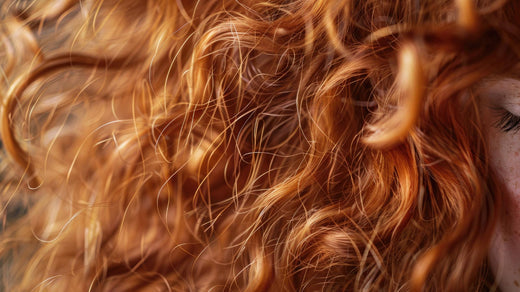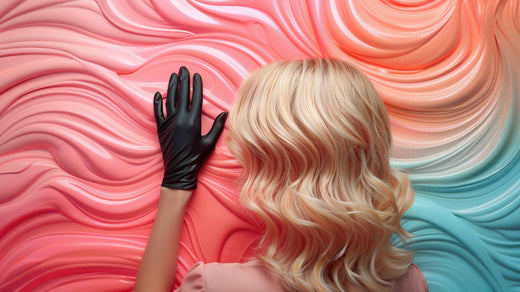
Discover the secret of radiant hair: hide grey hair with Henna
Table of contents
- Why do gray hairs appear?
- How chemical hair dyes work
- Advantages of vegetable dyes
- How Radhe Shyam Henna Works to Color Gray Hair
- Why use Radhe Shyam henna to cover grey hair?
In the quest for dazzling locks, many people face the dilemma of how to cover those pesky grey hairs without damaging their hair. At Radhe Shyam, we understand this challenge and bring you the solution: henna for hair! Discover how this ancient natural wonder can become your ally for vibrant, healthy hair.

Why do gray hairs appear?
Before we dive into the fascinating world of henna to hide gray hair, it's important to understand why these unwanted companions appear in our hair. Gray hair is a natural result of the aging process, when hair follicles stop producing melanin, the pigment responsible for hair color. There are also other reasons why we can get gray hair, such as diseases like vitiligo, vitamin B12 deficiencies or thyroid. Although this process is inevitable, we can approach it with grace and style thanks to the wonders of henna.
How do chemical hair dyes work?
Chemical hair dyes are a popular option for covering gray hair and changing hair color. They work by using a combination of chemical ingredients designed to penetrate the hair cuticle and alter its pigmentation. Here's how they work in detail:
Cuticle penetration:
Chemical dyes contain oxidizing agents, such as hydrogen peroxide, which open the hair cuticle, the protective outer layer. This opening allows the coloring ingredients to penetrate the hair more effectively.
Reaction with Melanin:
Once inside the hair, the artificial pigments present in the chemical dye react with the natural melanin in the hair. Melanin is the pigment responsible for hair color and is found in different concentrations in each person.
Changes in pigmentation:
Chemical dyes can make two main types of changes to hair pigmentation:
Lightening: If you want to lighten your hair, the pigments in the chemical dye react with the natural melanin to bleach it and then new pigments are deposited to create the desired color.
Darkening or changing color: To darken the hair or change its color, the pigments in the chemical dye cover the natural melanin with new pigments, thus altering the tone of the hair.
Fixing and sealing:
Once the desired color has been achieved, a fixing solution is applied to stabilize the pigments in the hair. This solution helps to close the hair cuticle again, which helps to retain the color and provides shine and softness to the hair.
Durability:
Chemical dyes offer longer-lasting coloring compared to natural dyes, as the artificial pigments adhere more firmly to the hair. However, this process can be harsher on the hair and scalp, which can result in damage and weakening over time.

Advantages of Vegetable Dyes
Naturalness and sustainable origin
Vegetable dyes, such as henna, are derived from natural plants and herbs, such as Lawsonia inermis in the case of henna. This organic nature makes them an environmentally friendly and sustainable option.
Softness and nutrition
Unlike chemical dyes that can damage the hair structure, plant-based dyes tend to be gentler and more nourishing. The natural ingredients present in these dyes, such as proteins, vitamins and minerals, help strengthen and condition the hair, leaving it softer and more manageable.
Less aggressive
Vegetable dyes do not contain harsh chemicals such as ammonia or hydrogen peroxide, which are common in conventional chemical dyes. This makes them less irritating to the scalp and less damaging to the hair structure, thus reducing the risk of dryness, brittleness and split ends.
Gradual gray hair coverage
Although plant-based dyes may initially offer less intense coverage than chemical dyes, their action is gradual and continuous. Over time and with regular use, plant-based dyes provide effective and natural coverage of grey hair, without the risk of a marked root effect.
Durability and color stability
Despite their natural origin, plant-based dyes can offer long-lasting and stable colouring. When applied correctly and maintained with care, plant-based shades can maintain their intensity and luminosity for weeks or even months, especially with the use of specific care products for coloured hair.
How Radhe Shyam Henna Works to Color Gray Hair
Penetration and deposition
Henna contains natural pigment molecules that have the ability to penetrate the hair cuticle and deposit in the cortex, the innermost layer of the hair. When applied to the hair, henna adheres to the hair structure, covering gray hair evenly.
Color intensification
Once deposited on the hair, henna reacts with the proteins present in the hair fiber, gradually developing its characteristic color. This color intensification process can vary depending on the exposure time and ambient temperature, allowing the intensity of the tone to be adjusted according to individual preferences.
Effective gray hair coverage
Henna is especially effective at covering gray hair due to its ability to adhere to the hair cuticle and penetrate the porous areas where gray hair is found. Unlike some chemical dyes that may struggle to cover stubborn gray hair, henna offers even, long-lasting coverage.
Conditioning effect
In addition to coloring hair, henna also acts as a natural conditioner. Its moisturizing and nourishing properties help strengthen hair, improve its texture and increase its shine, leaving it soft and manageable after coloring.

Why use Radhe Shyam henna to cover grey hair?
At Radhe Syham, we take pride in offering a range of top-quality henna products, designed to give you an exceptional colouring experience. Our henna not only covers grey hair effectively, but also cares for and protects your hair, allowing you to look radiant and healthy with every application. Trusting Radhe Shyam henna is choosing natural beauty, hair care and sustainability. Discover the transformative power of henna and join us on the journey to hair full of colour and vibrancy. Your hair deserves the best, and at Radhe Shyam, we are here to deliver!



Leave a comment
This site is protected by hCaptcha and the hCaptcha Privacy Policy and Terms of Service apply.